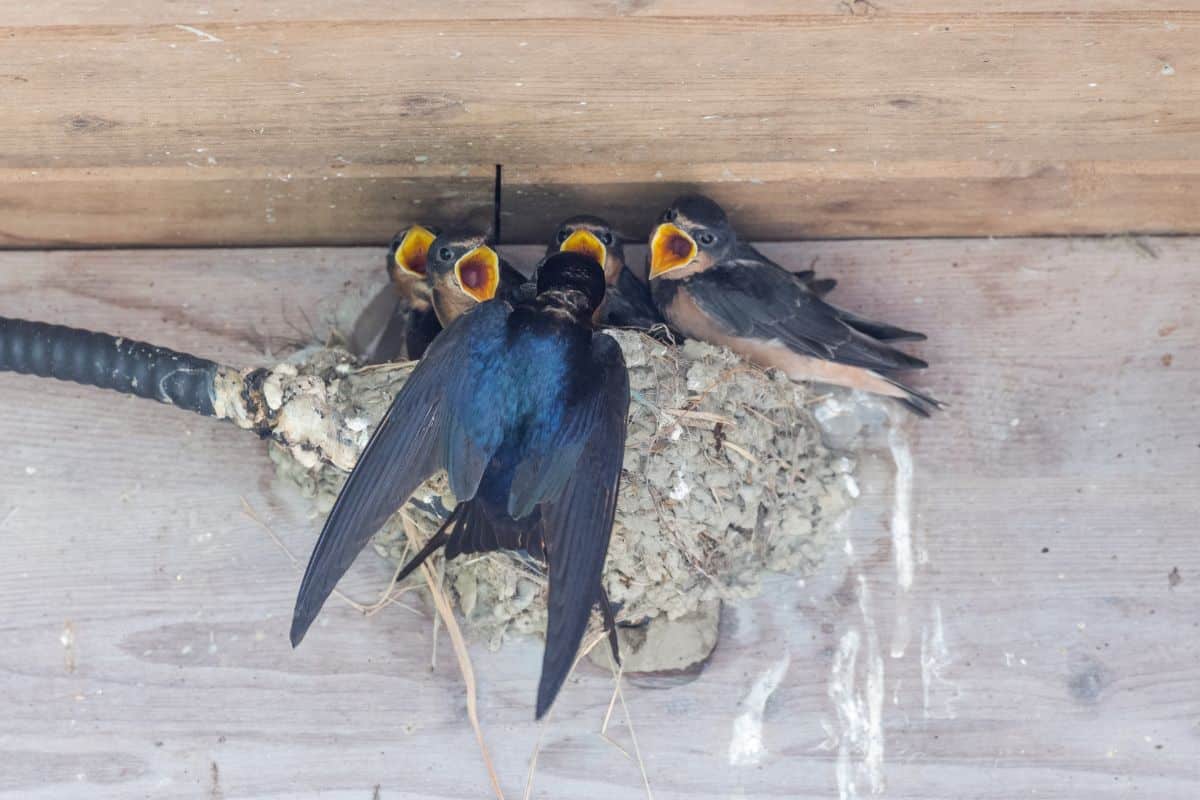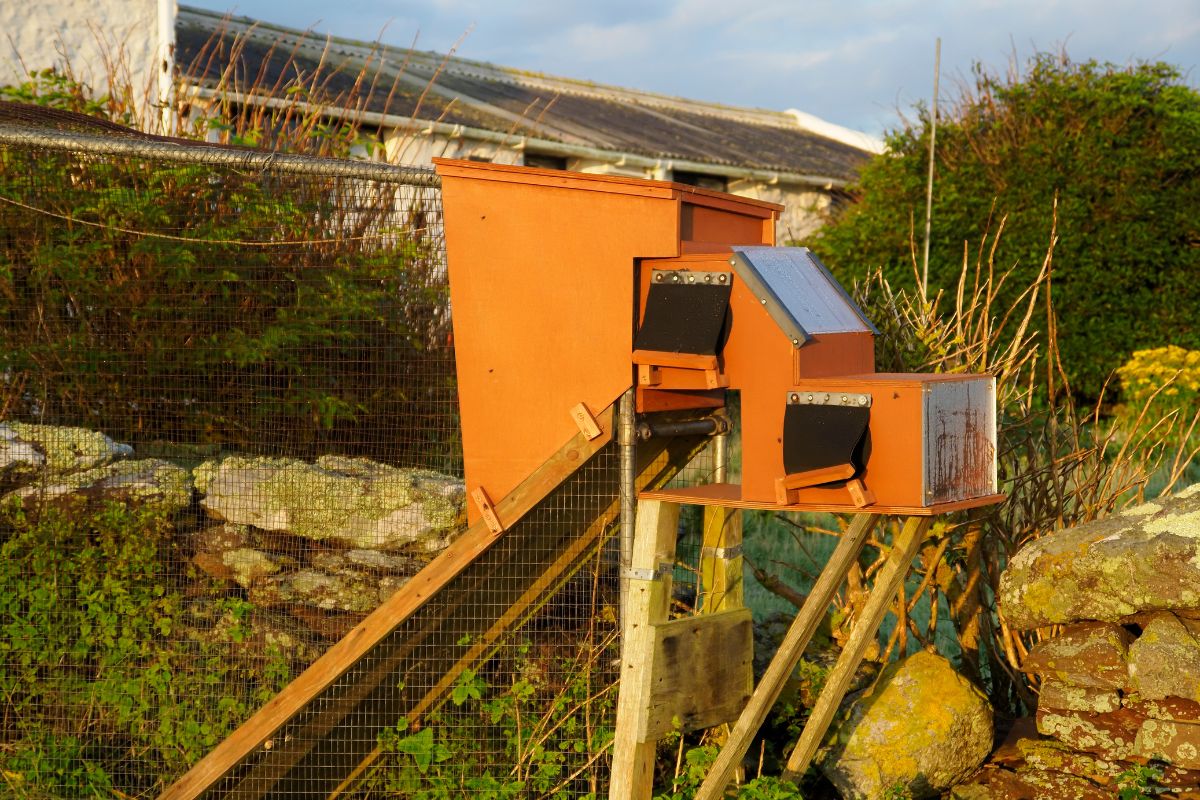Birds are lovely creatures that gracefully flit to and fro while singing. Unless they nest in your barn, where they eat grain, poop on livestock and equipment, and otherwise make nuisances of themselves.

Birds can be detrimental to farm operations. Their feces carry bacteria and microorganisms harmful to you and your livestock, so you naturally look for a way to get rid of them.
Contents
Step 1: Identify the Birds
The first step to getting rid of birds is to see what species they are. These are some of the most popular barn-dwellers peeking at you from the rafters. Different species have different diets and habits, so there are various ways to get rid of them.
Pigeons
Pigeons are a nonnative species that feed on various sources, from seeds to handouts from well-meaning humans. They’re attracted to food in barns, and their nests are messy, flat platforms made of sticks, garbage, and grass. They’re very used to humans, so you’ll have to use a different scaring method than a scarecrow to get them to leave.
European Starlings
European starlings gather in large flocks and are attracted to the food in and around barns. They’re a nonnative species that love a seed, grains, and insects. Starlings might not be too bad to keep around as long as you prevent them from nesting in barns, as they devour a staggering number of insects a day. Placing birdhouses and fountains far from your barn may keep them from nesting there.
House Sparrows
House sparrows will eat seed and grain along with bugs, but they’re mainly after a peaceful place to raise chicks. They nest in cavities like drain pipes or holes in rafters and can cause a lot of building damage if not kept in check.
Owls
Owls are pretty helpful to have around. They rarely nest in busy buildings, choosing to call abandoned barns and quiet sheds home. Since they prefer desolate places, cleanliness is rarely an issue, and they’ll hunt rodents in a wide radius around them, providing you with free pest control for a place to stay.
Step 2: Implement a Short-Term Solution

Once you know what you’re dealing with, you can start by implementing a short-term solution to keep birds away from your barns. This usually consists of scaring them away, whether you use a decoy or go up into the rafters to chase them out regularly.
Scarecrows and Decoys
No products found.
Scarecrows aren’t always effective as birds have likely gotten used to human presence in and around barns. However, setting up a giant, more predatory bird decoy like an owl or a duck can be highly effective. At least, at first.
As time goes on, birds will realize it’s fake and end up setting nests right next to them, so while they’re away, you need to work on implementing a long-term solution.
Noisemakers
No products found.
Manual and electric noisemakers create predatory noises or startling sounds that scare birds away. However, its effectiveness varies, and birds get used to it after some time.
Step 3: Remove Nests
The next step is to eliminate any reasons the birds might come back. Check local and state laws for removing bird nests, as removing the nest of a protected, native bird is illegal in most areas. However, most birds drawn to barns are nonnative and can legally be removed. It is why identifying the birds you’re dealing with is so important.
You might not have the heart to remove nests with eggs and baby birds. Wait for them to grow up, then remove the nest. It usually takes a month. Also, laws might differ depending on whether babies are in the nest.
Step 4: Seal Up Barn

Place heavy plastic coverings over doorways, and seal up any holes a half an inch in diameter to keep birds from getting in. Without any easy access points, birds will give up nesting there.
Step 5:Bird-Proof Your Operation
Place feed in bird-proof containers, place coverings over feed and water troughs, and the water should be far enough from the edge that a bird can’t dip down and drink but deep sufficient that birds can’t stand in the water.
Step 6: Modify Ledges
If this isn’t enough to solve your bird problem, you’ll have to use more drastic methods, starting with ledges where birds like to gather.
Bird Spikes
Birds don’t like bird spikes because they can’t get comfortable with them, causing them to fly away. Placing bird spikes on ledges where birds gather in your barn will prevent them from landing, so they’ll stay away.
Chemical Repellents
You can place chemical repellents on your ledges that make them slippery or sticky. But this doesn’t work as well outside, as the dust and weather will wear the chemicals off. Birds don’t like the sensation and will remember not to land there again.
Step 7: Set Up Traps

If you’re still having trouble with birds, it’s time to take the problem into your own hands or call a professional. Setting up traps, removing the birds from the premises, or contacting a bird control specialist are some of the best ways to ensure birds don’t come back.
Bob Traps
Bob traps are popular bird traps where the birds can enter one way but can’t get back out. Once they’re inside, you can release them far away from your barn.
Funnel Traps
Funnel traps are more extensive, and birds can fly out of these, so you should check them often. A large funnel brings birds into an enclosure they have trouble getting out of, but it’s not impossible. Check these traps often and put any birds you find into a separate compartment for transfer and release.
FAQ
Keeping birds out of barns is easier said than done, but it is possible with some dedication.
What is a good bird deterrent?
Shiny objects are significant bird deterrents because they mimic movement, which birds don’t like. After all, the movement may be from a predator or other territorial bird.
What smells will keep birds away?
Strong smells are disliked by birds and most of the animal kingdom, which includes things like peppermint and vinegar.
Will aluminum foil keep birds away?
Aluminum foil and pie tins are great for laying down or stringing up near perches and ledges to keep birds away.
Do shiny wind chimes keep birds away?
Yes, both because it’s shiny and moves in the wind and because of the noise it makes that can frighten birds. It doubles as both a visual and an auditory deterrent.
